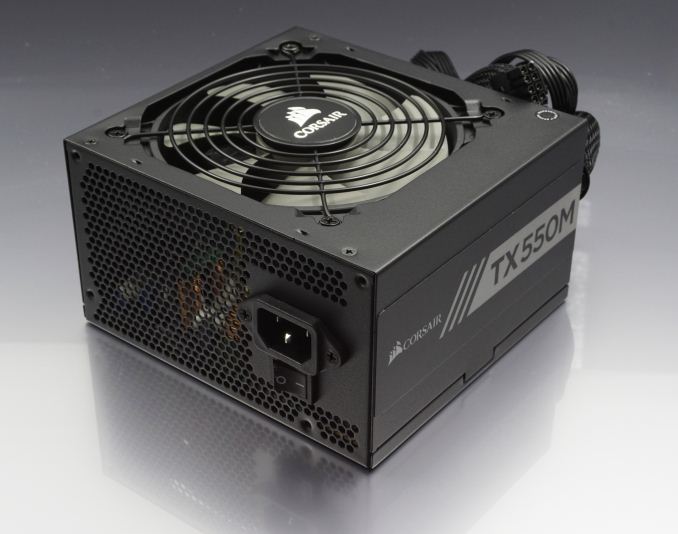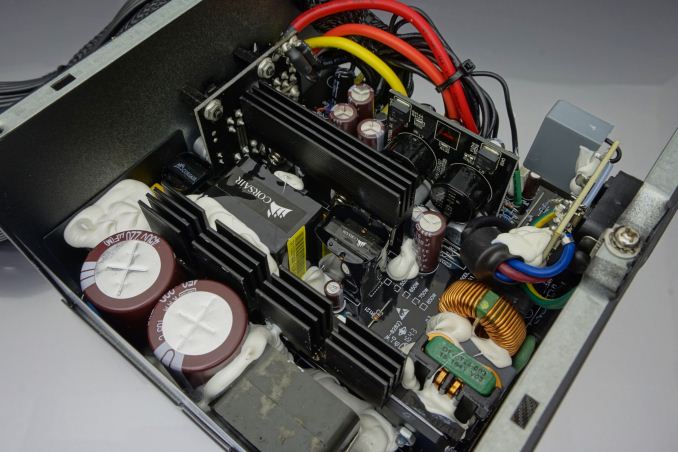The $80 Power Supply for Almost Everyone: The Corsair TX550M 80Plus Gold PSU Review
by E. Fylladitakis on December 1, 2017 8:00 AM EST- Posted in
- Cases/Cooling/PSUs
- Corsair
- PSUs
- 550W
- TX
- Modular
- Power Supply
Conclusion
With the TX-M series, Corsair is trying to fill the gap between its low-cost products and the high performance HX/AX series. The TX-M PSUs are designed to entice the average user who wants something better than a basic model, yet without having to break the bank in order to obtain it. Today we reviewed the least powerful model of the series, the TX550M. As its name implies, the TX550M has a maximum power output of 550W, which is more than adequate for typical single-GPU gaming/workstation systems. It is rated for continuous operation at 50°C and comes with an 80Plus Gold efficiency certification.
The Corsair TX550M is based on a platform by Great Wall, a Chinese OEM, which Corsair has been cooperating with for several of their PSUs over the past few years. This is the most advanced version of this platform that we have seen to this date, boosting the efficiency (just) enough for the PSU to earn an 80Plus Gold efficiency certification. Corsair’s optimizations did not stop there, as their engineers also managed to significantly improve the power quality of the PSU, resulting to low ripple/noise levels for a PSU of this class. The voltage regulation also is very good. Overall, the electrical performance of the TX550M is excellent for a “mainstream” PSU.
On the other hand, the thermal performance could use a few upgrades. The TX550M is neither too hot or too loud - just unsophisticated. Its thermal control feels archaic by today’s standards, when it could have a more powerful fan paired with a start/stop function, allowing it to operate fanless when possible but also keep the temperatures low when needed. The TX550M however is using the fan all the time, even when it does not really need to, making the PSU audible when it could be entirely quiet. On the other hand, the mediocre fan can barely provide enough airflow to maintain safe operating temperatures under adverse environmental conditions. Overall, the thermal control of the TX550M certainly works, but it could do much better.
Aesthetics are a subjective matter, but making the TX series aesthetically unique or attractive clearly was not Corsair’s focus. Unlike the more expensive PSUs of the company, the TX-M does not feature a custom chassis with chamfered edges and other aesthetic improvements. It is using a typical ATX steel chassis, with its only aesthetic improvements being a matte black paint and a semi-modular design. In terms of quality, Corsair is using components only from renowned manufacturers and we also found the assembly job of the TX550M to be excellent. It is no chance that the company is covering the latest TX-M units with a seven year warranty. The TX550M is a PSU designed to reliably serve for many years.
Summing up the above, the TX550M is a very reliable PSU with good electrical performance, making it an ideal choice for users who want to power a typical single GPU gaming/workstation system and have no need for extra/exotic features. Its current retail price of $80 is reasonable, yet it can be frequently found on sale for less than $70 (the 650W version is on sale for $74 at the time of this review), offering an outstanding value-to-performance ratio and long-term reliability.












42 Comments
View All Comments
t.s - Saturday, December 2, 2017 - link
I mean, all the peripheral on your example is not something that will make the system spent, like 150W1_rick - Friday, December 1, 2017 - link
Well, that makes something like this model overkill for a lot of people, then. Just as an example, I have a Corsair CX-430 PSU, an overclocked Ryzen 1600X, and a GTX 950. During a GPU stress test, it will pull a bit under 250 watts. CPU stress tests are somewhat lower--I think under 200W. It idles well under 100, and normal usage is probably 120-160W.mjeffer - Friday, December 1, 2017 - link
This is one of my annoyances whenever building a new system. It's really hard to find a high quality, low wattage PSU that would represent your true needs. Most major vendors only go budget on low wattage or it's impossible to find someone who's done a teardown to see if it is made with quality parts because reviews are usually only done on grossly overpowered PSUsKAlmquist - Saturday, December 2, 2017 - link
I've been happy with the Seasonic SSR-360GP, but sadly it appears to have been discontinued. I guess the Antec EarthWatts EA-380 is worth a look.Manabu - Monday, December 18, 2017 - link
It is getting harder and harder to find high quality low wattage PSUs with enough cables. I'm using 6 sata and 3 ide and 1 6-pin vga cable (gtx 650 ti). My overclocked system draws up to 250W (measured at the wall) with linpack AVX2 and Furmark, but more normal high load is like 150-175W. Thus I would want a 350W psu for a good margin and efficiency.Instead I had to buy a 450W 80+gold psu (electricity here is expensive and it runs 24h/d). Previously I used a 420W 80+ bronze psu for 6 years and before that a 400W 80+ psu for 5 years. Power ratings are creeping up, but at least efficiency too. Still, if power ratings continue to go up efficiency for my loads will go down.
jhapp - Friday, December 1, 2017 - link
People need reliability, not 3D graphics. I always buy PNY/Quadro high resolution 2D cards which run about 10 watts per monitor. 3D video cards are expensive and energy wasting. Add them to the long list of things people don't need but think they do because of media hype, like hi-res tvs, or hybrid cars, ethanol, E85, smart phones, cell phones, ...Jimios - Friday, December 1, 2017 - link
I'd like to see you play a modern game with a 10W 2D Quadro.MadAd - Friday, December 1, 2017 - link
With CPUs providing basic graphics these days I dont think the average user would buy a 3d card unless they actually had an app demanding it, eg for me Planetside 2 wouldnt even work without a serious graphics card, otherwise I wouldnt bother and just use the onboard.Dr. Swag - Friday, December 1, 2017 - link
But if you want to play video games...LukaP - Friday, December 1, 2017 - link
Even if you dont, iGPUs exist, on both sides...